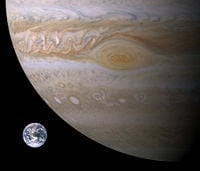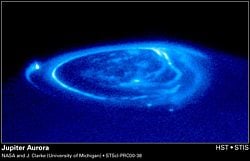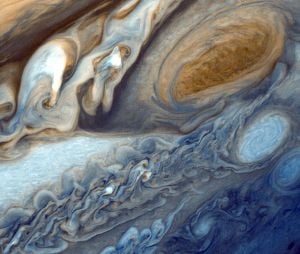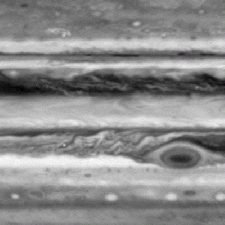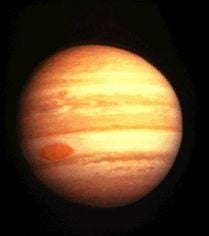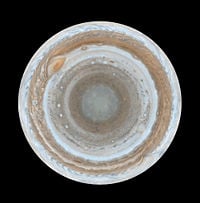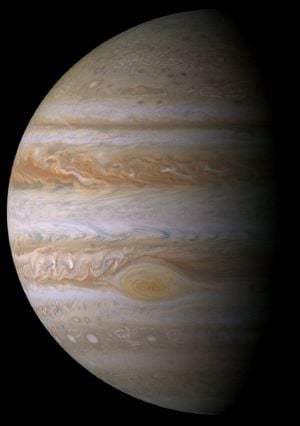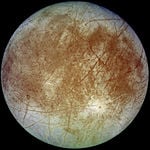Jupiter
- Note: For the Roman god Jupiter please click here.
Overview
Jupiter is usually the fourth brightest object in the sky, after the Sun, the Moon, and Venus. At times, however, Mars appears brighter than Jupiter.
Jupiter is 2.5 times more massive than all the other planets combined, so massive that its center of mass with the Sun actually lies above the Sun's surface (1.068 solar radii from the Sun's center). It is 318 times more massive than Earth, with a diameter 11 times that of Earth, and its volume is 1300 times as great as that of Earth. Quite naturally, Jupiter's gravitational influence probably played a large role in the evolution of the Solar System.
Most planetary orbits lie closer to Jupiter's orbital plane than the Sun's equatorial plane. (Mercury is the only planet that is closer to the Sun's equator in orbital tilt.) The majority of short-period comets belong to Jupiter's family (a result of Jupiter's mass and relative speed), the gaps ("Kirkwood gaps") in the distribution of asteroids in the main belt are mostly due to Jupiter, and the planet may have been responsible for the Late Heavy Bombardment of the inner Solar System's history. Jupiter has been called the Solar System's vacuum cleaner, due to its immense gravity well.
As impressive as Jupiter's mass is, extrasolar planets have been discovered with much greater masses. There is no clear-cut definition of what distinguishes a large planet such as Jupiter from a brown dwarf star, although the latter possesses rather specific spectral lines. Currently, if an object of solar metallicity—the proportion of its matter made up of chemical elements other than hydrogen and helium—is 13 time Jupiter's mass or larger, large enough to burn deuterium, it is considered a brown dwarf; below that mass (and orbiting a star or stellar remnant), it is considered a planet.[1] Jupiter is thought to have about as large a diameter as a planet of its composition can; adding extra mass would cause the planet to shrink due to increased gravitational compression. The process of further shrinkage with increasing mass would continue until stellar ignition would be achieved. This has led some astronomers to term it a "failed star." Although Jupiter would need to be about 75 times as massive to become a star, the smallest red dwarf is only about 30 percent larger than Jupiter.
It is also interesting to note that Jupiter radiates more heat than it receives from the Sun. This additional heat radiation is produced by the "Kelvin-Helmholtz mechanism:" As the planet's surface cools, the pressure drops and the planet undergoes compression, which heats up the planet's core. This mechanism is evident on Jupiter and Saturn. It is estimated that Jupiter radiates more energy through this mechanism than it receives from the Sun. As another symptom of this process, the planet shrinks at the rate of a few millimeters each year.
When they were younger and hotter, Jupiter and the other gas giant planets were much larger than they are today. However, because of its lower mass and weaker gravitational pull, Saturn would expand more rapidly than Jupiter with increasing heat. On that basis, one might argue that Saturn must have formerly been larger than Jupiter.
Jupiter also has the fastest rotation rate of any planet within the Solar System, making a complete rotation on its axis in slightly less than ten hours, which results in an equatorial bulge easily seen through an Earth-based amateur telescope. Jupiter is perpetually covered with a layer of clouds, composed of ammonia crystals and possibly ammonium hydrosulfide. It may not have any solid surface, in that the density may simply increase gradually as one moves toward the core.
Jupiter's best-known feature is the Great Red Spot, a storm larger than the Earth's size. Mathematical models suggest that the storm is stable and may be a permanent feature of the planet.[2] It is therefore likely that this spot was first observed by Giovanni Domenico Cassini and Robert Hooke four centuries ago. In 2000, three small spots merged to form a larger spot, named Oval BA, which later acquired a red hue very similar to that of the Great Red Spot.[3]
Historical observations
The planet Jupiter has been known since ancient times and is visible to the naked eye in the night sky. The Romans named the planet after the Roman god Jupiter (also called Jove). The astronomical symbol for the planet is a stylized representation of the god's lightning bolt.
The Chinese, Korean, Japanese, and Vietnamese refer to the planet as the "wood star,"[4] based on the Chinese Five Elements. In Vedic Astrology, Hindu astrologers refer to Jupiter as Brihaspati, or "Guru" which means the "Big One." In Hindi, Thursday is referred to as Guruvaar (day of Jupiter). In the English language Thursday is rendered as Thor's day, with Thor being identified with the Roman god Jupiter.
In 1610, Galileo Galilei discovered the four largest moons of Jupiter, Io, Europa, Ganymede, and Callisto (now known as the Galilean moons) using a telescope, the first observation of moons other than Earth's. This was also the first discovery of a celestial motion not apparently centered on the Earth. It was a major point in favor of Copernicus' heliocentric theory of the motions of the planets; Galileo's outspoken support of the Copernican theory placed him under the threat of the Inquisition.
In 1892, E. E. Barnard observed a fifth satellite of Jupiter with the 36-inch refractor at Lick Observatory in California. The discovery, a testament to his extraordinary eyesight, made him quickly famous. The moon was later named Amalthea.
Physical characteristics
Planetary composition
Jupiter is composed of a relatively small rocky core, surrounded by metallic hydrogen, with further layers of liquid hydrogen and gaseous hydrogen. There is no clear boundary or surface between these different phases of hydrogen; the conditions blend smoothly from gas to liquid as one descends.
Atmosphere
Jupiter's atmosphere is composed of ~90 percent hydrogen/~10 percent helium by number of atoms and ~75 percent hydrogen/~24 percent helium by mass, with ~1 percent of the mass accounted for by other substances. The interior contains denser materials such that the distribution is ~71 percent/24 percent/5 percent for hydrogen/helium/other by mass. The atmosphere contains trace amounts of methane, water vapor, ammonia, and "rock." There are also traces of carbon, ethane, hydrogen sulfide, neon, oxygen, phosphine, and sulfur. The outermost layer of the atmosphere contains crystals of frozen ammonia.[5] Through IR and UV measurements benzene (at a relative mixing ratio of 2x10-9 to hydrogen) and other hydrocarbons have also been found.[6]
This atmospheric composition is very close to the composition of the solar nebula. Saturn has a similar composition, but Uranus and Neptune have much less hydrogen and helium.
Jupiter's upper atmosphere undergoes differential rotation, an effect first noticed by Giovanni Cassini in 1690. The rotation of Jupiter's polar atmosphere is ~5 minutes longer than that of the equatorial atmosphere. In addition, bands of clouds of different latitudes, known as tropical regions flow in opposing directions on the prevailing winds. The interactions of these conflicting circulation patterns cause storms and turbulence. Wind speeds of 600 km/h are not uncommon.
The only spacecraft to have descended into Jupiter's atmosphere to take scientific measurements is the Galileo probe. It sent an atmospheric probe into Jupiter upon arrival in 1995, then itself entered Jupiter's atmosphere and burned up in 2003.
The Great Red Spot
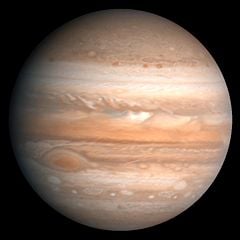 Click image for description | |||||||
|---|---|---|---|---|---|---|---|
| Orbital characteristics (Epoch J2000) | |||||||
| Semi-major axis | 778,412,027 km 5.203 363 01 AU | ||||||
| Orbital circumference | 4.888 Tm 32.675 AU | ||||||
| Eccentricity | 0.048 392 66 | ||||||
| Perihelion | 740,742,598 km 4.951 558 43 AU | ||||||
| Aphelion | 816,081,455 km 5.455 167 59 AU | ||||||
| Orbital period | 4333.2867 d (11.86 a) | ||||||
| Synodic period | 398.88 d | ||||||
| Avg. Orbital Speed | 13.056 km/s | ||||||
| Max. Orbital Speed | 13.712 km/s | ||||||
| Min. Orbital Speed | 12.446 km/s | ||||||
| Inclination | 1.305 30° (6.09° to Sun's equator) | ||||||
| Longitude of the ascending node |
100.556 15° | ||||||
| Argument of the perihelion |
274.197 70° | ||||||
| Number of satellites | 63 | ||||||
| Physical characteristics | |||||||
| Equatorial diameter | 142,984 km [1] (11.209 Earths) | ||||||
| Polar diameter | 133,709 km (10.517 Earths) | ||||||
| Oblateness | 0.064 87 | ||||||
| Surface area | 6.14×1010 km2 (120.5 Earths) | ||||||
| Volume | 1.431×1015 km3 (1321.3 Earths) | ||||||
| Mass | 1.899×1027 kg (317.8 Earths) | ||||||
| Mean density | 1.326 g/cm3 | ||||||
| Equatorial gravity | 23.12 m/s2 (2.358 gee) | ||||||
| Escape velocity | 59.54 km/s | ||||||
| Rotation period | 0.413 538 021 d (9 h 55 min 29.685 s)[2] | ||||||
| Rotation velocity | 12.6 km/s = 45,300 km/h (at the equator) | ||||||
| Axial tilt | 3.13° | ||||||
| Right ascension of North pole |
268.05° (17 h 52 min 12 s) | ||||||
| Declination | 64.49° | ||||||
| Albedo | 0.52 | ||||||
| Surface temp. |
| ||||||
| Adjective | Jovian | ||||||
| Atmospheric characteristics | |||||||
| Atmospheric pressure | 70 kPa | ||||||
| Hydrogen | ~86% | ||||||
| Helium | ~14% | ||||||
| Methane | 0.1% | ||||||
| Water vapor | 0.1% | ||||||
| Ammonia | 0.02% | ||||||
| Ethane | 0.0002% | ||||||
| Phosphine | 0.0001% | ||||||
| Hydrogen sulfide | <0.00010% | ||||||
The Great Red Spot is a persistent anticyclonic storm on the planet Jupiter, 22° south of the equator, which has lasted at least 340 years. The storm is large enough to be visible through Earth-based telescopes. It was probably first observed by Giovanni Domenico Cassini, who described it around 1665.
This dramatic view of Jupiter's Great Red Spot and its surroundings was obtained by Voyager 1 on February 25, 1979, when the spacecraft was 9.2 million km (5.7 million miles) from Jupiter. Cloud details as small as 160 km (100 miles) across can be seen here. The colorful, wavy cloud pattern to the left of the Red Spot is a region of extraordinarily complex and variable wave motion. To give a sense of Jupiter's scale, the white oval storm directly below the Great Red Spot is approximately the same diameter as Earth.
The oval object rotates counterclockwise, with a period of about 6 days. The Great Red Spot's dimensions are 24–40,000 km × 12–14,000 km. It is large enough to contain two or three planets of Earth size. The cloud tops of this storm are about 8 km above the surrounding cloud tops.
Storms such as this are not uncommon within the turbulent atmospheres of gas giants. Jupiter also has white ovals and brown ovals, which are lesser unnamed storms. White ovals tend to consist of relatively cool clouds within the upper atmosphere. Brown ovals are warmer and located within the "normal cloud layer." Such storms can last hours or centuries.
Before the Voyager missions, astronomers were uncertain of the nature of Jupiter's Great Red Spot. Many believed it to be either a solid or a liquid feature on the planet's surface as this appears consistent with the observable turbulence patterns.
Recent examination of Jupiter's surface by a NASA research team using the Hubble telescope has shown that several smaller storms located near the Giant Red Spot have, in the last twelve months, amalgamated, increased in intensity and changed color from white to red.[7] Further investigations on this Oval BA, nicknamed Red Spot Jr., using spectroscopy have been delayed due to the movement of Jupiter behind the Sun and it is yet to be verified if the phenomenon is caused by increased wind speed, comparable to those in the larger anomaly, drawing similar materials from deeper in the atmosphere and exposing them to sunlight. Given the relatively sudden development of Oval BA in the last 12 months and the as yet unconfirmed nature of the cause of either of the red spots, it is still open to speculation. It could be atmospheric activity drawing material up from closer to the planet's surface or it might be thermal activity on the surface throwing gases and debris upwards.
Planetary rings
Jupiter has a faint planetary ring system composed of smoke-like dust particles knocked from its moons by energetic meteor impacts. The innermost donut-shaped ring, called the halo, is almost as thick (20,000 km) as it is wide (22,800 km). This is followed by the thinnest and brightest main ring, which is made of dust from the satellites Adrastea and Metis. Metis orbits within its fluid Roche limit with Jupiter, and objects not rigidly attached to it may freely fall away from it and into Jupiter's gravitational field. Two wide gossamer rings encircle the main ring, originating from Thebe and Amalthea. Finally, there is a distant and very faint outer ring circling Jupiter backwards—retrograde of its spin. It is not known for certain where the material for this outer ring comes from, but it may be captured interplanetary dust.
Magnetosphere
Jupiter has a very large and powerful magnetosphere. In fact, if one could see Jupiter's magnetic field from Earth, it would appear five times as large as the full moon in the sky, despite being so much farther away. The magnetic field is generated by eddy currents (caused by a moving magnetic field intersecting a conductor) in Jupiter's metallic hydrogen core. This magnetic field collects a large flux of particle radiation in Jupiter's radiation belts, as well as producing a dramatic gas torus and flux tube associated with Io (one of Jupiter's moon). Jupiter's magnetosphere is the largest planetary structure in the solar system.[8]
The Pioneer probes confirmed that Jupiter's enormous magnetic field is 10 times stronger than Earth's and contains 20,000 times as much energy. The sensitive instruments aboard found that the Jovian magnetic field's "north" magnetic pole is at the planet’s geographic south pole, with the axis of the magnetic field tilted 11 degrees from the Jovian rotation axis and offset from the center of Jupiter in a manner similar to the axis of the Earth's field. The Pioneers measured the bow shock of the Jovian magnetosphere to the width of 26 million kilometers (16 million miles), with the magnetic tail extending beyond Saturn’s orbit.
The data showed that the magnetic field fluctuates rapidly in size on the sunward side of Jupiter because of pressure variations in the solar wind, an effect studied in further detail by the two Voyager spacecraft. It was also discovered that streams of high-energy atomic particles are ejected from the Jovian magnetosphere and travel as far as the orbit of the Earth. Energetic protons were found and measured in the Jovian radiation belt and electric currents were detected flowing between Jupiter and some of its moons, particularly Io.
Exploration of Jupiter
Since 1973, a number of automated spacecraft have visited Jupiter. Flights to other planets within the Solar System are accomplished at a cost in energy, which is described by the net change in velocity of the spacecraft, or delta-v. Reaching Jupiter from Earth requires a delta-v of 9.2 km/s,[9] which is comparable to the 9.7 km/s delta-v needed to reach low Earth orbit.[10] Fortunately, gravity assists through planetary flybys can be used to reduce the energy required to reach Jupiter, albeit at the cost of a significantly longer flight duration.
Pioneer flyby missions
Pioneer 10 flew past Jupiter in December of 1973, followed by Pioneer 11 exactly one year later. Pioneer 10 obtained the first ever close up images of Jupiter and the Galilean moons, studied its atmosphere, detected its magnetic field, observed its radiation belts and found that Jupiter is mainly liquid.
Voyager flyby missions
Voyager 1 flew by in March 1979, followed by Voyager 2 in July of the same year. The Voyagers vastly improved the understanding of the Galilean moons and discovered Jupiter's rings. They also took the first close up images of the planet's atmosphere.[11]
Ulysses flyby mission
In February 1992, Ulysses solar probe performed a flyby of Jupiter at a distance of 409,000 km (6.3 Jovian radii). This critical maneuver was required for Ulysses to attain a polar orbit around the Sun. During this pass the probe conducted studies on Jupiter's magnetosphere. However, since there were no cameras on board the probe, no images were taken. In February 2004, the probe came again in the vicinity of Jupiter. This time the distance was much greater—about 240 million km.[12]
Galileo mission
So far, the only spacecraft to orbit Jupiter is the Galileo orbiter, which went into orbit around Jupiter on December 7, 1995. It orbited the planet for over seven years and conducted multiple flybys of all of the major Galilean moons and Amalthea. The spacecraft also witnessed the impact of Comet Shoemaker-Levy 9 into Jupiter as it approached the planet in 1994, giving a unique vantage point for this spectacular event. However, while the information gained about the Jovian system from the Galileo mission was extensive in its own right, its originally-designed capacity was limited by the failed deployment of its high-gain radio transmitting antenna.[13]
An atmospheric probe was released from the spacecraft in July 1995. The probe entered the planet's atmosphere on December 7, 1995. It parachuted through 150 km of the atmosphere, collecting data for 57.6 minutes, before being crushed by the extreme pressure to which it was subjected. It would have melted and vaporized shortly thereafter. The Galileo orbiter itself experienced a more rapid version of the same fate when it was deliberately steered into the planet on September 21, 2003, at a speed of over 50 km/s, in order to avoid any possibility of it crashing into and possibly contaminating Europa, one of the Jovian moons.
Cassini flyby mission
In 2000, the Cassini probe, en route to Saturn, flew by Jupiter and provided some of the highest-resolution images ever taken of the planet. On December 19, 2000, the Cassini spacecraft, captured a very low resolution image of the moon Himalia, but it was too distant to show any surface details.
New Horizons flyby mission
The New Horizons probe and its Atlas V launcher lifted off from Pad 41 at Cape Canaveral Air Force Station, Florida, directly south of Space Shuttle Launch Complex 39, at 2:00 p.m. EST (1900 UTC) on January 19, 2006. New Horizons passed lunar orbit before midnight EST on the same day, and was scheduled to reach Jupiter in February 2007. It's plan was to pass through the Jupiter system at 21 km/s (47,000 mph), with closest approach to Jupiter occurring at approximately 06:00 UTC February 28, 2007.
The flyby was planned come within about 32 Jovian radii (3 Gm) of Jupiter and would be the center of a 4-month intensive observation campaign. New Horizons also has instruments built twenty years after Galileo's—particularly Galileo's cameras, which were evolved versions of the Voyager cameras which, in turn, were evolved Mariner cameras. Because of the much shorter distance from Jupiter to Earth, the communications link can transmit multiple loadings of the memory buffer. The mission will actually return more data from Jupiter than Pluto. Imaging of Jupiter began on September 4, 2006.
Future probes
NASA is planning a mission to study Jupiter in detail from a polar orbit. Named Juno, the spacecraft is planned to launch by 2010.
Because of the possibility of a liquid ocean on Jupiter's moon Europa, there has been great interest to study the icy moons in detail. A mission proposed by NASA was dedicated to study them. The JIMO (Jupiter Icy Moons Orbiter) was expected to be launched sometime after 2012. However, the mission was deemed too ambitious and its funding was canceled.
Natural satellites
Jupiter has at least 63 moons. The four large moons, known as the "Galilean moons," are Io, Europa, Ganymede, and Callisto. The Galilean moons were first observed by Galileo on January 7, 1610.
Galilean moons
The orbits of Io, Europa, and Ganymede (the largest moon in the Solar System) form a pattern known as a Laplace resonance; for every four orbits that Io makes around Jupiter, Europa makes exactly two orbits and Ganymede makes exactly one. This resonance causes the gravitational effects of the three moons to distort their orbits into elliptical shapes, since each moon receives an extra tug from its neighbors at the same point in every orbit it makes.
The tidal force from Jupiter, on the other hand, works to circularize their orbits. This constant tug of war causes regular flexing of the three moons' shapes, Jupiter's gravity stretches the moons more strongly during the portion of their orbits that are closest to it and allowing them to spring back to more spherical shapes when they're farther away. This flexing causes tidal heating of the three moons' cores. This is seen most dramatically in Io's extraordinary volcanic activity, and to a somewhat less dramatic extent in the geologically young surface of Europa indicating recent resurfacing.
| The Galilean moons, compared to Earth's moon Luna | |||||
|---|---|---|---|---|---|
| Name (Pronunciation key) |
Diameter (km) |
Mass (kg) |
Orbital radius (km) | Orbital period (days) | |
| Io | eye'-oe | 3643 (105% Luna) |
8.9×1022 (120% Luna) |
421 700 (110% Luna) |
1.77 (6.5% Luna) |
| Europa | ew-roe'-pə | 3122 (90% Luna) |
4.8×1022 (65% Luna) |
671 034 (175% Luna) |
3.55 (13% Luna) |
| Ganymede | gan'-ə-meed | 5262 (150% Luna) |
14.8×1022 (200% Luna) |
1 070 412 (280% Luna) |
7.15 (26% Luna) |
| Callisto | kə-lis'-toe | 4821 (140% Luna) |
10.8×1022 (150% Luna) |
1 882 709 (490% Luna) |
16.69 (61% Luna) |
Classification of Jupiter's moons
Before the discoveries of the Voyager missions, Jupiter's moons were arranged neatly into four groups of four. Since then, the large number of new small outer moons has complicated this picture. There are now thought to be six main groups, although some are more distinct than others. A basic division is between (a) the eight inner regular moons with nearly circular orbits near the plane of Jupiter's equator, which are believed to have formed with Jupiter; and (b) an unknown number of small, irregular moons, with elliptical and inclined orbits, which are believed to be captured asteroids or fragments of captured asteroids.
- Regular moons:
- The inner group of four small moons all have diameters of less than 200 km, orbit at radii less than 200,000 km, and have orbital inclinations of less than half a degree.
- The four Galilean moons, discovered by Galileo Galilei and Simon Marius, orbit between 400,000 and 2,000,000 km, and include some of the largest moons in the solar system.
- Irregular moons:
- Themisto is in a group of its own, orbiting halfway between the Galilean moons and the next group.
- The Himalia group is a tightly clustered group of moons with orbits around 11,000,000-12,000,000 km from Jupiter.
- Carpo is another isolated case; at the inner edge of the Ananke group, it revolves in the direct sense.
- The Ananke group is a group with rather indistinct borders, averaging 21,276,000 km from Jupiter with an average inclination of 149 degrees.
- The Carme groupis a fairly distinct group that averages 23,404,000 km from Jupiter with an average inclination of 165 degrees.
- The Pasiphaë group is a dispersed and only vaguely distinct group that covers all the outermost moons.
It is thought that each group of outer moons may have a common origin, perhaps as a larger moon or captured body that broke up.
Life on Jupiter
It is considered highly unlikely that there is any Earth-like life on Jupiter, as there is little water in the atmosphere and any possible solid surface deep within Jupiter would be under extraordinary pressures. However, in 1976, before the Voyager missions, Carl Sagan hypothesized (with Edwin Ernest Salpeter) that ammonia-based life could evolve in Jupiter's upper atmosphere. Sagan and Salpeter based this hypothesis on the ecology of terrestrial seas, which have simple photosynthetic plankton at the top level, fish at lower levels feeding on these creatures, and marine predators that hunt the fish. The Jovian equivalents Sagan and Salpeter hypothesized were "sinkers," "floaters," and "hunters." The "sinkers" would be plankton-like organisms which fall through the atmosphere, existing just long enough that they can reproduce in the time they are kept afloat by convection. The "floaters" would be giant bags of gas functioning along the lines of hot air balloons, using their own metabolism (feeding off sunlight and free molecules) to keep their gas warm. The "hunters" would be almost squid-like creatures, using jets of gas to propel themselves into "floaters" and consume them.[14]
Trojan asteroids
In addition to its moons, Jupiter's gravitational field controls numerous asteroids which have settled into regions known as "Lagrangian points" preceding and following Jupiter in its orbit around the Sun. They are called Trojan asteroids and are divided into Greek and Trojan "camps," to commemorate the Iliad. The first of these, 588 Achilles, was discovered by Max Wolf in 1906. Since then, hundreds more have been discovered. The largest among them is 624 Hektor.
Trojan asteroids are dominated by so-called D-type asteroids, which are believed to be abundant in hydrous minerals, carbon, and organics.[15] However, unlike the D-type asteroids in the main asteroid belt, remote observations indicate no sign of water on Trojan asteroids. This lack of water may be due to heavy space weathering, for these asteroids are stable in orbit and their surfaces are believed to be much older than those in the main belt.
Cometary impact
During the period July 16 to 22, 1994, over twenty fragments from the comet Shoemaker-Levy 9 hit Jupiter's southern hemisphere, providing the first direct observation of a collision between two solar system objects. It is thought that due to Jupiter's large mass and location near the inner solar system it receives the most frequent comet impacts of the solar system's planets. Shoemaker-Levy 9 split into smaller pieces due to Jupiter's tidal force before the impact.
Footnotes
- ↑ Working Group on Extrasolar Planets: Definition of a "Planet," IAU position statement. Retrieved June 8, 2007.
- ↑ J. Sommeria, S.D. Meyers, and H.L. Swinney H.L., "Laboratory simulation of Jupiter's Great Red Spot," Nature, 331, (1988): 689-693.
- ↑ NASA, Jupiter's New Red Spot. Retrieved June 8, 2007.
- ↑ Ellie Crystal's Metaphysical and Science Website, Jupiter. Retrieved June 8, 2007.
- ↑ D. Gautier, et al, "The helium abundance of Jupiter from Voyager", Journal of Geophysical Research, 86, (1981): 8713-8720 (Abstract).
- ↑ S.J. Kim, J. Caldwell, A.R. Rivolo, R. Wagner, "Infrared Polar Brightening on JupiterIII. Spectrometry from the Voyager 1 IRIS Experiment," Icarus, 64, (1984): 233-248.
- ↑ A. Simon-Miller, et al, "Jupiter's White Oval turns red," Icarus 185, (2006): 558-562.
- ↑ The Astrophysics Spectator, "Jupiter's Magnetosphere."
- ↑ Project Galileo Homepage, Galileo FAQ. Retrieved June 8, 2007.
- ↑ Rockets and Space Transportation, Delta V in the Solar System. Retrieved June 8, 2007.
- ↑ NASA Jet Propulsion Laboratory, Jupiter. Retrieved June 8, 2007.
- ↑ K. Chan, E. S. Paredes, M. S. Ryne, "Ulysses Attitude and Orbit Operations: 13+ Years of International Cooperation," American Institute of Aeronautics and Astronautics, (2004).
- ↑ NASA Jet Propulsion Laboratory, Galileo: Journey to Jupiter. Retrieved June 8, 2007.
- ↑ Encyclopedia of Astrobiology, Astronomy & Spaceflight [http://www.daviddarling.info/encyclopedia/J/Jupiterlife.html Life On Jupiter. Retrieved June 8, 2007.
- ↑ T. Hiroi, M.E. Zolensky, and C.M. Pieters, "The Tagish Lake meteorite: A possible sample from a D-type asteroid," Science, 293, (2001): 2234-2236.
ReferencesISBN links support NWE through referral fees
- Bagenal, Fran, Timothy E. Dowling, William B. McKinnon (Eds.) (2007). Jupiter: The Planet, Satellites, and Magnetosphere. Cambridge, UK; New York, NY: Cambridge University Press, New Ed Edition. ISBN 978-0521035453
- Beebe, Reta (2002). Jupiter: The Giant Planet (second edition). Washington, DC: Smithsonian Institute Press. ISBN 1560986859
- Seymour, Simon (1992). Our Solar System. New York, NY: HarperCollins. ISBN 978-0688099923
- Spangenburg, Ray, and Kit Moser (2002). A Look at Jupiter (Out of This World). London, UK: Franklin Watts. ISBN 0531165639
External links
All links retrieved February 28, 2025.
- NASA's Jupiter fact sheet.
- Jupiter: As Seen By Voyager 1 Data and photos on Jupiter.
- Galileo and the Medici Family.
- A simulation of the 62 Jovian moons.
| |||||||||||||||||||||||||||||||||||||||
| |||
|---|---|---|---|
| The Sun · Mercury · Venus · Earth · Mars · Ceres · Jupiter · Saturn · Uranus · Neptune · Pluto · Eris | |||
| Planets · Dwarf planets · Moons: Terran · Martian · Asteroidal · Jovian · Saturnian · Uranian · Neptunian · Plutonian · Eridian | |||
| SSSBs: Meteoroids · Asteroids (Asteroid belt) · Centaurs · TNOs (Kuiper belt/Scattered disc) · Comets (Oort cloud) | |||
| See also astronomical objects and the solar system's list of objects, sorted by radius or mass. |
Credits
New World Encyclopedia writers and editors rewrote and completed the Wikipedia article in accordance with New World Encyclopedia standards. This article abides by terms of the Creative Commons CC-by-sa 3.0 License (CC-by-sa), which may be used and disseminated with proper attribution. Credit is due under the terms of this license that can reference both the New World Encyclopedia contributors and the selfless volunteer contributors of the Wikimedia Foundation. To cite this article click here for a list of acceptable citing formats.The history of earlier contributions by wikipedians is accessible to researchers here:
The history of this article since it was imported to New World Encyclopedia:
Note: Some restrictions may apply to use of individual images which are separately licensed.
